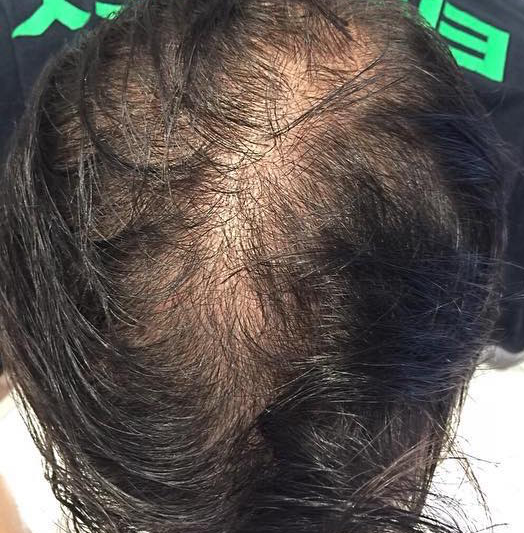Home / Hair Loss / Chemotherapy
Chemotherapy
It is likely that everyone knows a person who has undergone the trauma of being diagnosed with cancer and having to be treated by chemotherapy. It’s also common knowledge that one of its side effects can be hair loss. The disease, so distressing in itself, gives further distress and anxiety when one of the most upsetting side effects of treatment is loss of hair.
However, hair lost as a result of chemotherapy does grow back and there are methods to help reduce hair fall.
Why Chemotherapy Causes Hair Loss
Chemotherapy describes any treatment where ‘chemical’ agents are given intravenously. With cancer, the chemicals given during chemotherapy are used to destroy cancer cells, but these drugs can also have a toxic effect on other parts of your body and very often disrupt your natural hair growth cycle.
Chemotherapy can cause your hair to bypass the normal shedding (telogen) phase, and come out excessively in the hairs’ growing (anagen) phase. This is called anagen effluvium and usually occurs within 4-6 weeks of starting treatment. However, some chemotherapy never causes hair loss.
Cold Caps
Cold caps are tightly bandaged ice packs around the head. They inhibit the flow of the chemical therapy around your head and so limit the flow of chemicals to your scalp and hair capillaries. Some hair may still fall out, but not to the extent of near-baldness. However, cold caps can be unbearably uncomfortable and many find the amount of hair saved does not warrant using them.
Coping with Hair Loss
Individuals undergoing chemotherapy sometimes prefer to completely shave their heads before their treatments to gain a sense of control. It’s often less distressing to do this as hair fall is not as obvious and isn’t actively seen. We generally advise those with long hair to adopt a shorter style. Hair loss is less visible and emotionally it may be easier. Other ways to help cope with hair loss and to boost morale are to wear scarves, hats or hairpieces and wigs.
Modern wigs can look very natural and there are a wide range of different colours and textures to choose from. Wearing wigs won’t inhibit hair growth, but we advise you leave them off whenever possible to let your scalp breathe. Your scalp tissue still contains oil and sweat glands, so even if you lose your hair or shave it off, daily shampooing is best.
After Chemotherapy
In 99% of cases, hair does grow back after chemotherapy, but you may find your hair grows back differently. Your hair might change its colour, shape and/or texture. It could also initially grow back fine and fluffy. The latter is only a temporary change though, and your follicles will eventually produce mature hairs.
As soon as your hair has grown back, and is strong enough, you can start using conditioners and styling products as usual. Having your hair styled by a professional hairdresser who knows you and understands your situation can also be very helpful and reassuring. However, great care should be taken when styling initally to avoid pulling out and breaking new, fluffy hairs – this is especially true with massage. Hair colouring can also be continued, but a skin patch test must be done initially, regardless of applications before chemotherapy. This is particularly important with permanent hair dyes.
You can also begin to perm or highlight your hair once your hair has grown. While perms and highlights don’t cause allergies, a strand test must still be done on the first occasion after treatment. Even though it’s still your hair, the new hair may react differently than it did before.
What we do in our clinics for post-chemotherapy hair
Liz Phillips, Philip Kingsley Trichologist, New York: ‘As soon as your oncologist clears you for topical treatments, you can start to circulate, stimulate and increase blood flow to your scalp. Your follicles are going to want to grow hair. You can encourage this with appropriate treatments – such as scalp masks and prescribed stimulant drops, and perhaps changes to your diet and nutritional supplements if needed.’ For more information on treatments we offer at the Philip Kingsley Trichological Clinic, please contact us at either our London or New York office.
Radiotherapy
Localised radiotherapy can cause hair loss in the treated area. In breast cancer this includes the armpits. When the head is treated with radiotherapy, particularly in the treatment of brain tumours, hair follicles in direct contact are permanently destroyed. In many cases hair transplantation can be successful, but, as with other forms of cosmetic surgery, it’s essential that you are referred to the best specialists.
Related Trichological Articles
Philip Kingsley Trichologist, Glenn Lyons, Discusses Chemotherapy and Hair Loss
Learn more about:
Why Nina Ross Hair Therapy?
State of the art + PERSONALIZED TREATMENTS
Founder of NRHT - Shanina "Nina Ross" Lassiter
Transformations
View Real Patient Before & Afters
Reviews
see testimonials from current clients
Get answers from a specialist












